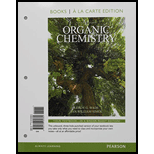
Organic Chemistry, Books a la Carte Edition (9th Edition)
9th Edition
ISBN: 9780134160382
Author: Leroy G. Wade, Jan W. Simek
Publisher: PEARSON
expand_more
expand_more
format_list_bulleted
Textbook Question
Chapter 17.4, Problem 17.4P
Use resonance forms to show that the dipolar sigma complex shown in the sulfonation of benzene has its positive charge delocalized over three carbon atoms and its negative charge delocalized over three oxygen atoms.
Expert Solution & Answer
Trending nowThis is a popular solution!

Students have asked these similar questions
If we assume a system with an anodic overpotential, the variation of n as a function
of current density:
1. at low fields is linear 2. at higher fields, it follows Tafel's law
Obtain the range of current densities for which the overpotential has the same value
when calculated for 1 and 2 cases (maximum relative difference of 5% compared to
the behavior for higher fields).
To which overpotential range does this correspond?
Data: i = 1.5 mA cm², T = 300°C, B = 0.64, R = 8.314 J K1 mol-1 and F = 96485 C mol-1.
Answer by equation please
Some of the theories used to describe interface structure can be distinguished by:1. the measured potential difference.2. the distribution of ions in solution.3. the calculation of charge density.4. the external Helmoltz plane.
Chapter 17 Solutions
Organic Chemistry, Books a la Carte Edition (9th Edition)
Ch. 17.1 - Prob. 17.1PCh. 17.2 - Prob. 17.2PCh. 17.3 - Prob. 17.3PCh. 17.4 - Use resonance forms to show that the dipolar sigma...Ch. 17.6A - Prob. 17.5PCh. 17.6A - Prob. 17.6PCh. 17.6B - Propose a mechanism for the brommation of...Ch. 17.6B - Prob. 17.8PCh. 17.6B - Prob. 17.9PCh. 17.7 - Prob. 17.10P
Ch. 17.8 - Draw all the resonance forms of the sigma complex...Ch. 17.9 - Predict the mononitration products of the...Ch. 17.9 - Predict the mononitration products of the...Ch. 17.9 - Prob. 17.14PCh. 17.10 - Propose products (if any) and mechanisms for the...Ch. 17.10 - Predict the products (if any) of the following...Ch. 17.10 - Which reactions will produce the desired product...Ch. 17.10 - Prob. 17.19PCh. 17.11C - Prob. 17.20PCh. 17.12A - Prob. 17.21PCh. 17.12B - Propose a mechanism that shows why p-chlorotoluene...Ch. 17.12B - Propose mechanisms and show the expected products...Ch. 17.12B - Prob. 17.24PCh. 17.13A - What products would you expect from the following...Ch. 17.13A - What organocuprate reagent would you use for the...Ch. 17.13B - What products would you expect from the following...Ch. 17.13B - Prob. 17.28PCh. 17.13C - What products would you expect from the following...Ch. 17.13C - Prob. 17.30PCh. 17.14C - Prob. 17.31PCh. 17.14C - Predict the major products of the following...Ch. 17.15A - Predict the major products of treating the...Ch. 17.15B - Prob. 17.34PCh. 17.15B - Prob. 17.35PCh. 17.15B - Predict the major products when the following...Ch. 17.15C - Prob. 17.37PCh. 17.15C - a. Based on what you know about the relative...Ch. 17.15C - Show how you would synthesize the following...Ch. 17.16A - The bombardier beetle defends itself by spraying a...Ch. 17.16B - Predict the products formed when m-cresol...Ch. 17.16B - Prob. 17.42PCh. 17.16B - Prob. 17.43PCh. 17.16B - Predict the site(s) of electophilic attack on...Ch. 17.16B - Prob. 17.45PCh. 17.16B - Prob. 17.46PCh. 17.16B - Propose a synthetic sequence of this...Ch. 17.16B - Prob. 17.48PCh. 17.16B - Starting from toluene, propose a synthesis of this...Ch. 17 - Prob. 17.50SPCh. 17 - Prob. 17.51SPCh. 17 - Show how you would synthesize the following...Ch. 17 - Predict the major products of the following...Ch. 17 - Predict the major products of bromination of the...Ch. 17 - What products would you expect from the following...Ch. 17 - Prob. 17.56SPCh. 17 - Prob. 17.57SPCh. 17 - The following compound reacts with a hot,...Ch. 17 - Prob. 17.59SPCh. 17 - Electrophilic aromatic substitution usually occurs...Ch. 17 - Prob. 17.62SPCh. 17 - The most common selective herbicide for killing...Ch. 17 - Furan undergoes electrophilic aromatic...Ch. 17 - Prob. 17.65SPCh. 17 - Bisphenol A is an important component of many...Ch. 17 - Prob. 17.67SPCh. 17 - Prob. 17.68SPCh. 17 - Prob. 17.69SPCh. 17 - In Chapter14, we saw that Agent Orange contains...Ch. 17 - Phenol reacts with three equivalents of bromine in...Ch. 17 - Prob. 17.72SPCh. 17 - Prob. 17.73SPCh. 17 - A common illicit synthesis of methamphetamine...Ch. 17 - Prob. 17.75SPCh. 17 - Prob. 17.76SPCh. 17 - Prob. 17.77SPCh. 17 - Prob. 17.78SP
Knowledge Booster
Learn more about
Need a deep-dive on the concept behind this application? Look no further. Learn more about this topic, chemistry and related others by exploring similar questions and additional content below.Similar questions
- When talking about the acidity of carboxylic acids, is it the same thing to say higher or stronger acidity?arrow_forwardUsing the following two half-reactions, determine the pH range in which $NO_2^-\ (aq)$ cannot be found as the predominant chemical species in water.* $NO_3^-(aq)+10H^+(aq)+8e^-\rightarrow NH_4^+(aq)+3H_2O(l),\ pE^{\circ}=14.88$* $NO_2^-(aq)+8H^+(aq)+6e^-\rightarrow NH_4^+(aq)+2H_2O(l),\ pE^{\circ}=15.08$arrow_forwardIndicate characteristics of oxodec acid.arrow_forward
- What is the final product when hexanedioic acid reacts with 1º PCl5 and 2º NH3.arrow_forwardWhat is the final product when D-galactose reacts with hydroxylamine?arrow_forwardIndicate the formula of the product obtained by reacting methyl 5-chloro-5-oxopentanoate with 1 mole of 4-penten-1-ylmagnesium bromide.arrow_forward
arrow_back_ios
SEE MORE QUESTIONS
arrow_forward_ios
Recommended textbooks for you
 Physical ChemistryChemistryISBN:9781133958437Author:Ball, David W. (david Warren), BAER, TomasPublisher:Wadsworth Cengage Learning,
Physical ChemistryChemistryISBN:9781133958437Author:Ball, David W. (david Warren), BAER, TomasPublisher:Wadsworth Cengage Learning, Chemistry: The Molecular ScienceChemistryISBN:9781285199047Author:John W. Moore, Conrad L. StanitskiPublisher:Cengage Learning
Chemistry: The Molecular ScienceChemistryISBN:9781285199047Author:John W. Moore, Conrad L. StanitskiPublisher:Cengage Learning

Physical Chemistry
Chemistry
ISBN:9781133958437
Author:Ball, David W. (david Warren), BAER, Tomas
Publisher:Wadsworth Cengage Learning,

Chemistry: The Molecular Science
Chemistry
ISBN:9781285199047
Author:John W. Moore, Conrad L. Stanitski
Publisher:Cengage Learning
Gerade and Ungerade Molecular Orbitals. (SYMMETRY OF MOLECULAR ORBITALS); Author: Edmerls;https://www.youtube.com/watch?v=dPY-lT5LN60;License: Standard YouTube License, CC-BY
Symmetry and chemical bonding part – 5 Molecular orbital formation (CHE); Author: Vidya-mitra;https://www.youtube.com/watch?v=g-42GmpBu0I;License: Standard Youtube License